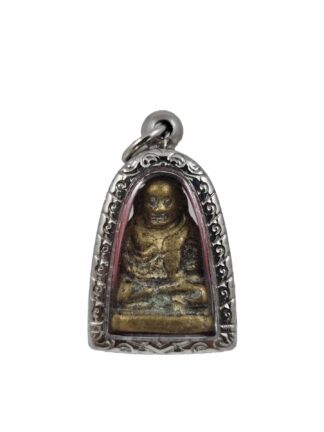Luang Phor Ngern
In B.E. 2351 (AD 1808), Luang Phor Ngern was born in Bangklan, Pichit Province, Thailand. His name, “Ngern,” translates to “money” or “silver” in Thai. He became a student of renowned guru monk Luang Phor Suk Wat Pak Klong Makamtao when he was 12 years old. He was ordained at Wat TongPu, now known as Wat Chana Songkhram. At 25, Luang Phor Ngern decided to return to his village in Bangkhlan, Pichit Province. But he discovered that a better environment could be more favourable for his practice. Before leaving, he prayed to Buddha and took three saplings of Bodhi leaves from the temple’s main entrance. He went to Wangtago village and planted three Bhoti tree seedlings there. He made a promise to build a temple there if the saplings grew. The saplings eventually reached maturity, and Wat Bangkhlan was built. As the temple’s abbot, he received a large number of visitors every day. Many people showed respect for Luang Por, offered themselves as his disciples, requested to hear the Dharma, and requested his assistance in healing their ailments. Wat Hirunyaram (Wat Bangkhlan) is the current name of the temple.
People along the Chao Phaya River knew Luang Phor Ngern’s miraculous abilities because he had built numerous Buddhist structures and helped those in need. Luang Phor Ngern’s life, which spanned until the age of 111, was devoted to practising Buddhism. On September 20, BE 2462, Luang Phor Ngern passed away.
In B.E. 2351 (AD 1808), Luang Phor Ngern was born in Bangklan, Pichit Province, Thailand. His name, “Ngern,” translates to “money” or “silver” in Thai. He became a student of renowned guru monk Luang Phor Suk Wat Pak Klong Makamtao when he was 12 years old. Luang Phor Ngern was ordained at Wat TongPu, now known as Wat Chana Songkhram. At 25, Luang Phor Ngern decided to return to his village in Bangkhlan, Pichit Province. But he discovered that a better environment could be more favourable for his practice. Before leaving, he prayed to Buddha and took three saplings of Bodhi leaves from the temple’s main entrance. He went to Wangtago village and planted three Bhoti tree seedlings there. He made a promise to build a temple there if the saplings grew. The saplings eventually reached maturity, and Wat Bangkhlan was built. As the temple’s abbot, Luang Phor Ngern received a large number of visitors every day. Many people showed respect for him, offered themselves as his disciples, requested to hear the Dharma, and requested his assistance in healing their ailments. Wat Hirunyaram (Wat Bangkhlan) is the current name of the temple.
People along the Chao Phaya River knew Luang Phor Ngern’s miraculous abilities because he had built numerous Buddhist structures and helped those in need. He’s life, which spanned until the age of 111, was devoted to practising Buddhism. On September 20, BE 2462, Luang Phor Ngern passed away.
Despite having dedicated many different kinds of amulets during his lifetime, Luang Phor Ngern is best known for his small cast statues. This statue had broad spiritual meanings related to boosting charms, bringing prosperity and luck, escaping dangers, and improving one’s safety.
Showing all 3 results
-

Luang Phor Ngern
$184 Add to cart -

Luang Phor Ngern
$147 Add to cart -

Luang Phor Ngern
$590 Add to cart
Showing all 3 results



